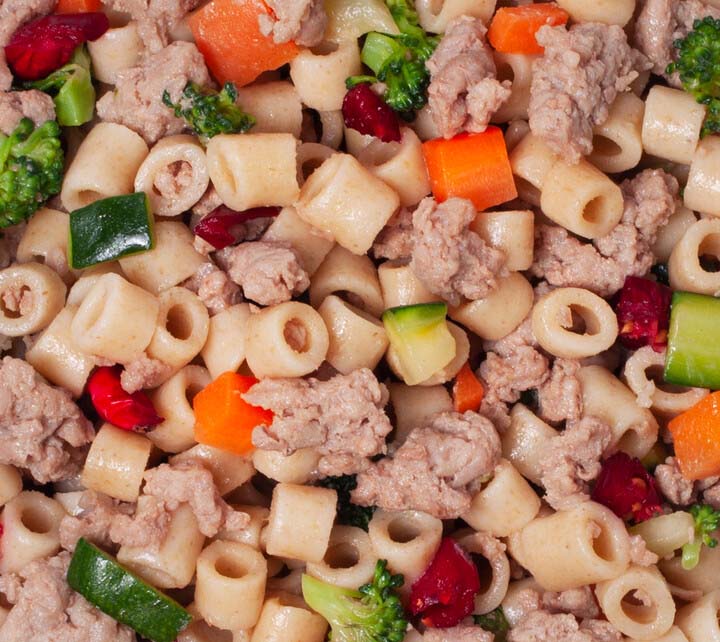Loving pet parents, particularly dog owners, have heard all the descriptors — raw food, natural food, fresh food, organic food, whole food, commercial dog food, and non-processed dog food. But what do these mean, and which is better for your dog’s diet?
It’s intuitive to think something natural, organic, or fresh would be better than something that’s processed, but is it true? As with most things, the answer to that question is, well, complex. Let’s dive a little deeper.
What Does It Mean?
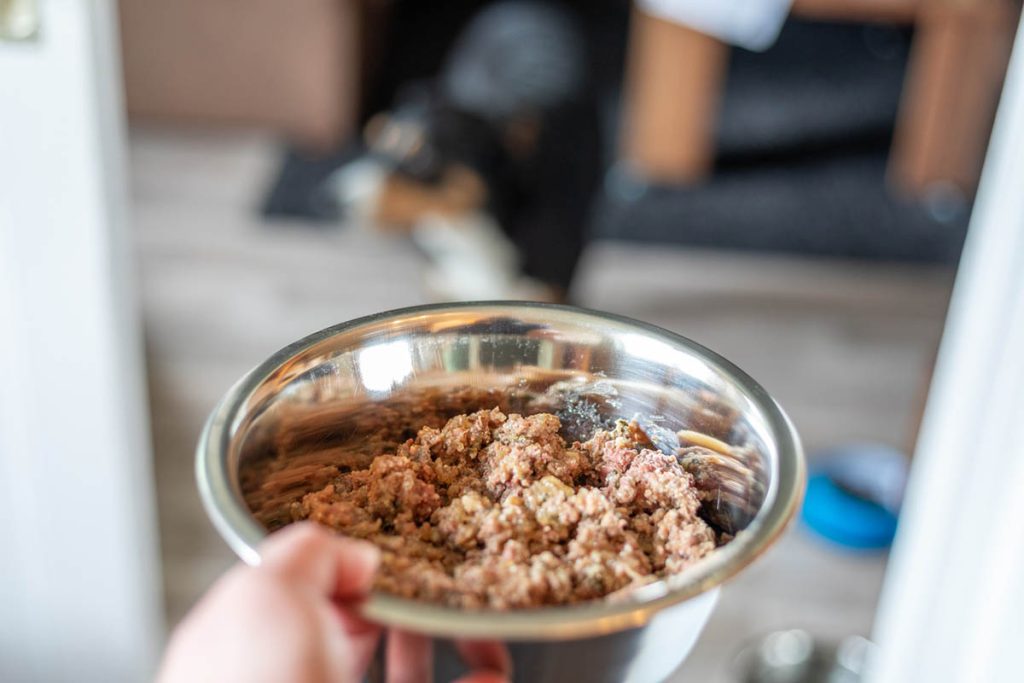
If you surf the Internet, you’ll see many different definitions and descriptions of various dog foods. It’s important to understand what those terms mean and learn how to tell if your dog’s food is as the producer describes and if it’s really better for your best friend.
Dry Dog Food (Kibble)
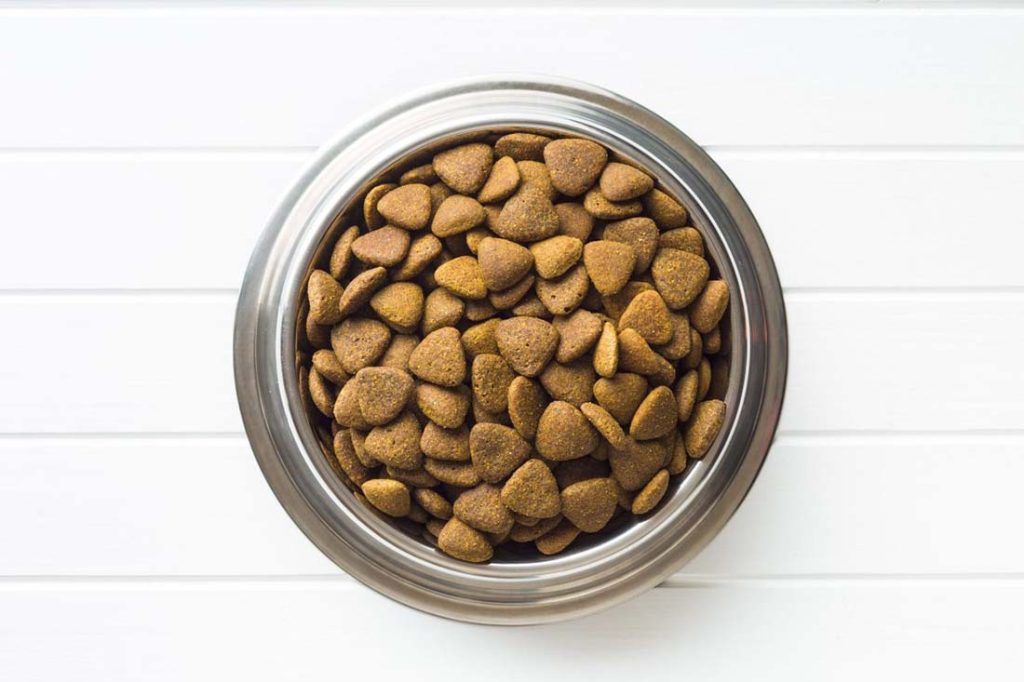
Many people like to feed their pooch dry dog food. It’s convenient to buy, store, and use. It’s also cheap, making it more affordable than other types of dog food. Moreover, it can be stored outside of the refrigerator. But does the processing involved mean that it’s not as good for your dog?
Many people think so. To make it shelf-stable and kill pathogens, the manufacturers put it through a process that, unfortunately, can also remove or destroy nutrients. After processing, the producers add those nutrients back, but in a synthetic form.
Additionally, because kibble is mass-produced, it often includes low-quality ingredients. That’s part of why it’s so much more affordable. Moreover, one study has found that feeding a processed, dry dog food diet to your pooch can significantly increase the risk of an ear infection (otitis) in certain life stages.
Wet Dog Food
Wet dog food is defined as pet food that has a moisture content of at least 65%. Because it is packaged differently and refrigerated after opening, wet food is usually more expensive than dry dog food.
On the upside, it is usually considered more palatable to your pet. However, it contains more fat, sodium, carrageenan, and it can cause more problems for your pet’s teeth. A dog food diet consisting of mainly wet food can cause dental problems like bad breath, more plaque buildup, and more oral bacteria that can cause tooth decay.
Non-Processed or Minimally Processed Dog Food
This is food that is produced from high-quality ingredients derived from plants, animals, or mined sources. Furthermore, those ingredients have either been left in their unprocessed state or minimally processed in a way that leaves whole ingredients as unaltered as possible. This helps to keep the nutrients and essential enzymes intact.
Additionally, minimally processed dog foods do not include any preservatives or fillers. Dog food that is considered minimally processed could be raw or lightly cooked. The term also includes freeze-dried dog foods.
Natural Dog Food
The Association of American Feed Control Officials (AAFCO) defines natural dog food as:
“A feed or ingredient derived solely from plant, animal or mined sources, either in its unprocessed state or having been subject to physical processing, heat processing, rendering, purification, extraction, hydrolysis, enzymolysis or fermentation, but not having been produced by or subject to a chemically synthetic process and not containing any additives (like artificial flavors, for example) or processing aids that are chemically synthetic except in amounts as might occur unavoidably in good manufacturing practices.”
That’s a long way to say that any ingredients in natural dog food should be, in fact, from natural sources. They should also not have undergone any chemically synthetic processes or contain additives or processing aids like artificial preservatives. The AAFCO definition of natural does allow for some synthetic trace nutrients in pet foods as long as they have nutritional value.
Some natural dog foods use a different type of process to avoid heating the food so they won’t need preservatives. Air-dried dog food and freeze-dried dog foods are two examples of natural dog foods that forego heating the food to high temperatures (or heating it at all).
You’ll likely notice this is a similar definition to non-processed dog food. In fact, AAFCO considers them to be the same despite minor differences in the definitions.
Organic Dog Food
The definition of organic dog food is somewhat different from the definition of natural or unprocessed dog food. To label a dog food organic, it must meet the U.S. Department of Agriculture’s (USDA) production and handling standards. These are the same standards as for human food.
The organic ingredients in pet foods with this label have to grow without using pesticides, artificial fertilizers, irradiation, genetic modification (i.e., non-gmo), or sewage sludge. Additionally, the protein sources for organic dog foods must come from animals that are themselves raised on organic feed, have access to the outdoors, and have not been treated with antibiotics or hormones.
Due to the more stringent standards, organic certification is a more complex process, and the organic ingredients are more expensive. That means organic dog food is more expensive than other dog food brands.
Raw Dog Food
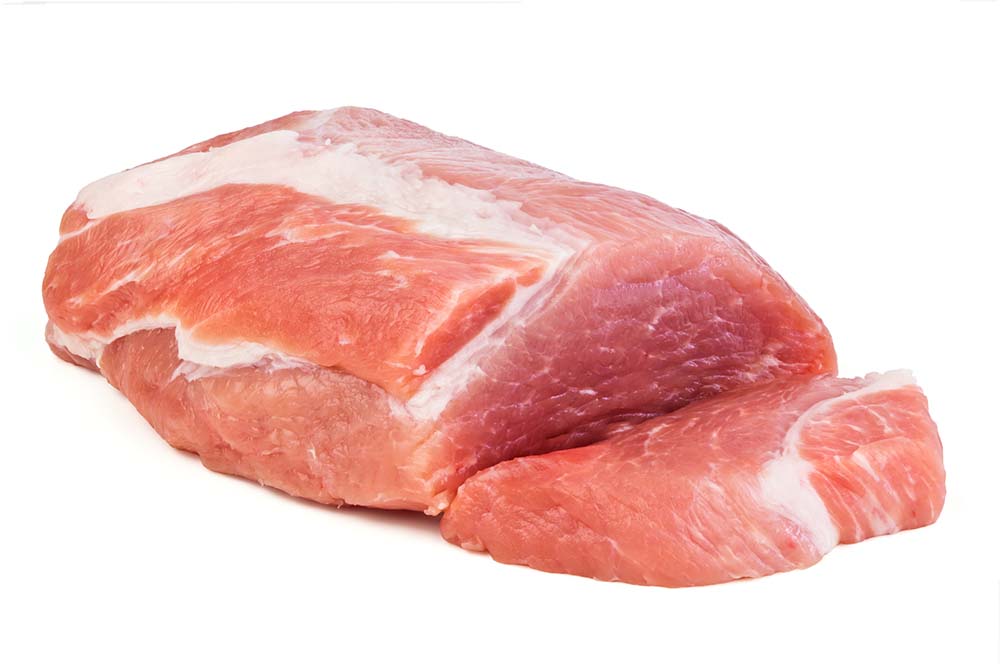
Raw dog food is defined as dog food that is nutrient-dense because it has not undergone any chemical changes, nor has it been exposed to heat processes that can kill essential nutrients. Many people believe it’s more natural to feed your dog raw dog food than other types of dog food.
It’s important to remember, however, that there are risks to feeding raw food to your dog. First, some dogs can have problems digesting raw food, particularly puppies and older adult dogs. They often have sensitive stomachs, and raw food can cause digestive problems.
Second, pet parents can’t always be sure where the animal protein in raw food comes from. There are fatality cases from a contaminated raw meat source.
Finally, while raw food does help control blood sugar spikes better than foods with high carbohydrate and starch content, there is also a risk that a raw food diet can be unbalanced. That means your pup might not get all of the vitamins and minerals he needs, which can result in health problems down the road.
Fresh Dog Food

The term fresh food refers to pre-cooked dog food made from real meat and vegetables. Moreover, fresh dog food is usually made from whole foods that have been minimally processed so that they retain their natural ingredients and nutrients while also being free of additives, fillers, unnecessary by-products, supplements, and preservatives.
The first ingredient in a fresh food dog food brand should be meat. You shouldn’t see any list of excess fillers like corn, soy, and wheat. Vegetables and rice, particularly brown rice, are fine. As is quinoa, but corn and soy, while cheaper, are not very nutritious for your pooch.
Most of the time, whole-food dog foods contain limited ingredients that include fresh fruits, vegetables, whole grains, and real meats, fish, and poultry. Such ingredients, when minimally processed (meaning lightly cooked at lower temperatures), allow your dog’s body to more easily absorb the nutrients.
Fresh dog food offers human-grade nutrition, meaning that it is safe for human consumption. To market it this way, all so-called human-grade ingredients have to be edible for humans. The food also has to meet federal manufacturing and packaging regulations.
Grain-Free Dog Food
Grain-free dog foods have gained popularity with some pet owners. The claim that dog food is grain-free, however, appears to be a euphemism for saying it is ‘low-carb’. AAFCO doesn’t allow pet food claims regarding carbohydrate content. So using the term grain-free achieves a marketing goal without making a specific claim about the carb content.
Grain-free diets utilize replacement ingredients for grains, like sweet potatoes, legumes, and tapioca. These replacements, however, can still be high in starches. Still, studies have shown that 50% of pet owners in the U.S. believe grain-free diets are healthier for their dogs.
Grain-free diets have become a popular way for pet parents with fur babies who have food allergies. There are, however, some concerns about feeding grain-free diets as well as boutique and exotic pet food diets (pet foods that contain alternative protein sources like kangaroo).
Grain-Free Diets and Heart Disease
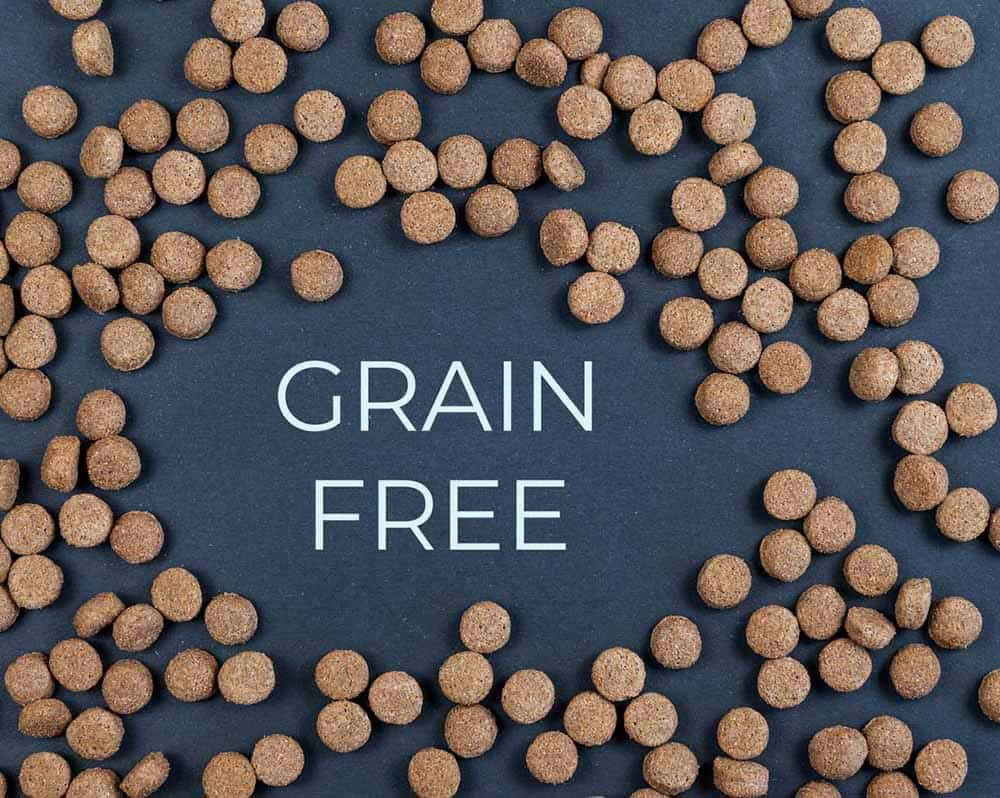
The concern revolves around a condition called dilated cardiomyopathy (DCM). This condition decreases the ability of the heart to pump blood. While some dog breeds are genetically predisposed to this problem — mostly large breed dogs — the Federal Drug Administration (FDA) has investigated cases of DCM in dogs without any known predisposition.
They found that of 515 cases of DCM in dogs not genetically predisposed to the condition, 90% were on a grain-free diet. 93% were on diets containing peas or lentils. They extensively tested the food for minerals, metals, and certain amino acids that could be causing the problem, but did not find any abnormalities. Still, another study found no difference between occurrences of DCM in dogs being fed a grain-free diet and those being fed a grain-based diet.
In the end, the experts couldn’t form any solid conclusions about the exact cause of the problem. They did, however, point to many cases of dogs with DCM whose condition improved or completely healed after the grain-free, boutique, or exotic diet they were on was removed and after starting amino acid supplementation. It’s possible, however, that the culprit in these cases is not
Which Diet Is Best for Your Dog?
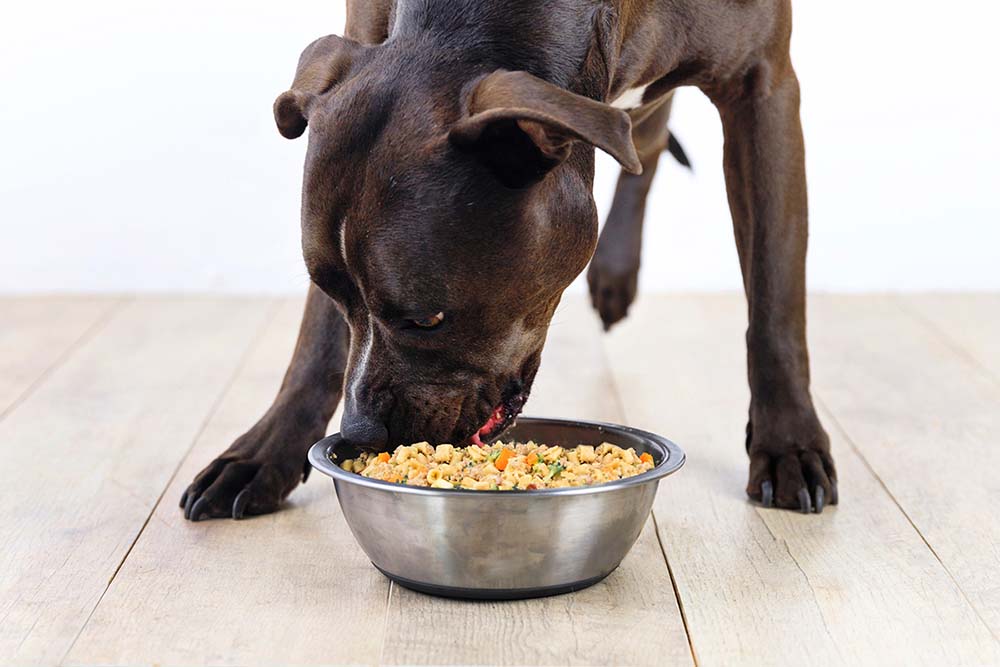
The answer to this is not simple, but there are a few things you should consider. First, you want to be sure to consult with a veterinary nutritionist before making any changes to your dog’s diet. They will help you design a feeding program that provides your pup with healthy food, avoiding any sensitivities your pooch may have.
As a loving pet parent, you want to make sure your best friend’s diet includes healthy proteins, veggies, and, yes, even carbohydrates. High-quality ingredients will provide your buddy with plenty of the vitamins, minerals, antioxidants, fatty acids, and other nutrients that are necessary for a longer, healthier, and happier life.
In addition, a nutritionist can determine if your dog needs any supplements, such as probiotics, to help regulate his digestive system. If you’re in the market for a fresh, whole dog food brand that offers human-grade nutrition, try JustFoodForDogs.
Our recipes used in professional studies show feeding fresh dog food promotes nutrient absorption, which in turn reduces fecal production. That means more nutrition and less poop. What loving pet parent doesn’t want that?
Even a little bit of fresh helps and we encourage pet parents to try it out as a topper. You can find our Beef recipe, Chicken recipe, Venison treats, fresh cat food, and more on our website, Chewy, Amazon, and Petco.
This content is for informational use only and does not replace professional nutrition and/or medical advice, diagnosis, or treatment. Do not rely on or use as a substitute for specific nutrition and/or medical recommendations. Please talk with your veterinarian about any questions or concerns.
Citations
Do, Sungho, Thunyaporn Phungviwatnikul, Maria R C de Godoy, and Kelly S Swanson. 2021. “Nutrient Digestibility and Fecal Characteristics, Microbiota, and Metabolites in Dogs Fed Human-Grade Foods.” Journal of Animal Science 99 (2). https://doi.org/10.1093/jas/skab028.
Banton, Sydney, Andrew Baynham, Júlia G. Pezzali, Michael von Massow, and Anna K. Shoveller. 2021. “Grains on the Brain: A Survey of Dog Owner Purchasing Habits Related to Grain-Free Dry Dog Foods.” PloS One 16 (5): e0250806. https://doi.org/10.1371/journal.pone.0250806.
Oba, Patrícia M, Kelly M Sieja, Stephanie C J Keating, Teodora Hristova, Amy J Somrak, and Kelly S Swanson. 2022. “Oral Microbiota Populations of Adult Dogs Consuming Wet or Dry Foods.” Journal of Animal Science, May. https://doi.org/10.1093/jas/skac200.
Research by DogRisk | DogRisk – Health via Nutrition, Epidemiology and Disease Detection Dogs | University of Helsinki.” n.d. Www.helsinki.fi. Accessed June 11, 2024. https://www.helsinki.fi/en/researchgroups/health-via-nutrition-epidemiology-and-disease-detection-dogs/research/research-by-dogrisk.
